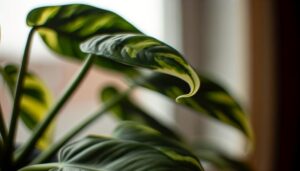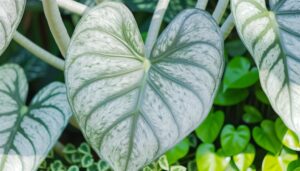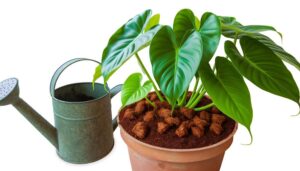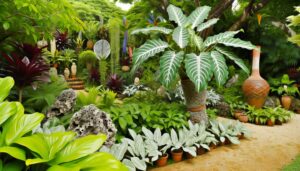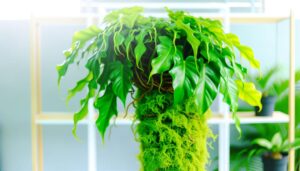What Are the Characteristics of Philodendron Verrucosum Hybrids?
Philodendron verrucosum hybrids are noted for their diverse foliage colors, ranging from greens to reds and purples, influenced by chlorophyll and anthocyanin concentrations. Their leaves are often heart-shaped or elongated with a velvety texture and intricate vein patterns.
These plants exhibit a climbing growth habit, utilizing robust yet flexible stems and aerial roots for support. Optimum growth is achieved in bright, indirect light and temperatures between 65-80°F.
They thrive in high humidity (60-80%) and are well-adapted to tropical environments. Understanding these traits can enhance your appreciation for these unique hybrids.

Key Takeaways
- Philodendron verrucosum hybrids have diverse foliage colors influenced by chlorophyll and anthocyanin concentrations.
- Leaf textures range from velvety to matte, enhancing the tactile experience.
- They exhibit a climbing growth habit with robust yet flexible stems and aerial roots.
- Optimal growth conditions include bright, indirect light and temperatures between 65-80°F.
- High humidity levels of 60-80% are essential for maintaining healthy growth.
Foliage Colors
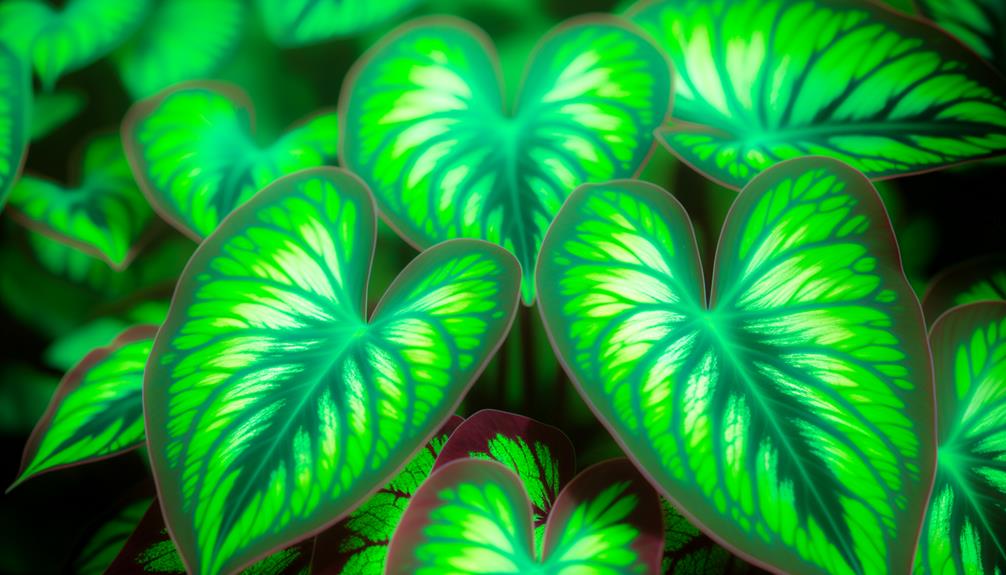
Philodendron verrucosum hybrids display a diverse range of foliage colors, from deep emerald greens to striking shades of burgundy and bronze. The pigmentation of these hybrids is influenced by both genetic factors and environmental conditions.
Chlorophyll concentration dictates the richness of green hues, while anthocyanins contribute to red and purple tones. Importantly, certain hybrids demonstrate a gradient of color changes as the leaves mature, shifting from lighter shades to deeper, more saturated colors. This phenotypic plasticity is an adaptive trait, potentially aiding in photoprotection and pest deterrence.
Additionally, the interplay of light intensity and nutrient availability can further modulate the coloration of the foliage, making Philodendron verrucosum hybrids a visually dynamic and scientifically intriguing group for horticultural study.
Leaf Patterns
In examining the leaf patterns of Philodendron Verrucosum hybrids, notable aspects include the vein color variations, which range from vivid reds to deep greens, contributing to the plant's striking appearance.
Additionally, the texture of the leaves often exhibits a velvety or matte finish, enhancing the tactile experience.
Leaf shapes can vary greatly, from heart-shaped to more elongated forms, each presenting unique aesthetic qualities.
Vein Color Variations
Among the distinguishing characteristics of Philodendron Verrucosum hybrids, the variations in vein color and leaf patterns are particularly notable for their intricate and diverse manifestations.
These hybrids exhibit a remarkable range of vein hues, from vivid crimsons and deep maroons to subtle silvers and bright greens. The contrast between the veins and the leaf blade creates visually striking patterns that enhance the plant's aesthetic appeal.
The reticulated venation is often highlighted by a velvet-like texture, contributing to the leaf's dynamic appearance. Such variations are not merely superficial but can also indicate the plant's health and genetic diversity.
Collectively, these attributes make Philodendron Verrucosum hybrids a subject of interest for botanists and horticulturists alike, reflecting the complexity of tropical plant phenotypes.
Texture and Shape
Leaf texture and shape in Philodendron Verrucosum hybrids reveal a fascinating interplay of morphological traits. They exhibit a combination of velvety surfaces and varied leaf contours that contribute to their distinct visual identity.
The adaxial (upper) leaf surface is typically covered with a fine, velvety pubescence, enhancing its tactile and aesthetic appeal. Leaf shapes vary from cordate (heart-shaped) to ovate, with margins that can range from smooth to slightly undulate.
The venation pattern, often prominent, adds a three-dimensional aspect to the leaf surface, accentuating its texture. Hybridization can introduce additional variations, such as increased leaf lobing or alterations in the degree of surface rugosity.
These morphological diversities underscore the hybrid's ornamental value and adaptive versatility.
Velvety Texture
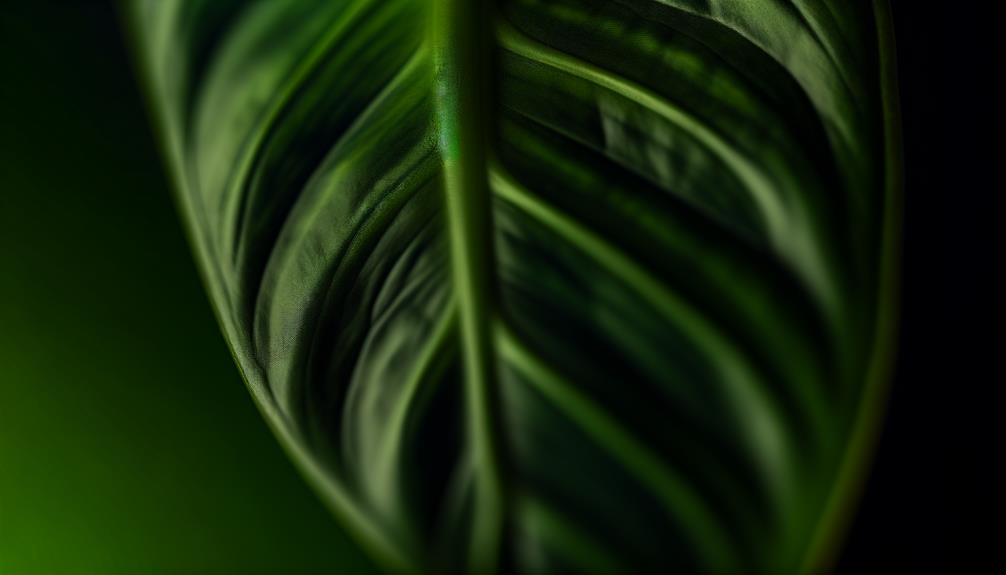
The velvety texture of Philodendron Verrucosum hybrids is attributable to the dense covering of trichomes on the leaf surface, which bestows a soft and tactile feel. This unique characteristic not only enhances the visual appeal but also offers several functional benefits:
- Water Retention: The trichomes reduce water loss by minimizing transpiration, assisting in the plant's overall hydration.
- Light Diffusion: The velvety surface scatters light, preventing leaf burn in high light conditions, thereby safeguarding the photosynthetic apparatus.
- Pest Deterrent: The dense trichomes can serve as a physical barrier against herbivorous insects, reducing harm and promoting plant health.
These attributes make the Philodendron Verrucosum hybrids particularly resilient and aesthetically pleasing, appealing to both botanists and horticulturists.
Growth Habit
Philodendron Verrucosum hybrids exhibit a climbing growth habit, characterized by their ability to ascend and attach to vertical supports using aerial roots. This vining nature allows them to thrive in both natural and controlled environments, where they can climb trees or trellises.
The aerial roots, which emerge from the nodes along the stem, facilitate nutrient absorption and water uptake, enhancing their adaptability. These hybrids display a remarkable capacity for vertical growth, often reaching substantial heights if adequately supported. Their stems are robust yet flexible, enabling them to entwine around structures efficiently.
This growth habit not only contributes to their aesthetic appeal but also underscores their evolutionary adaptation to forest understories, where climbing provides access to light and space.
Light Requirements
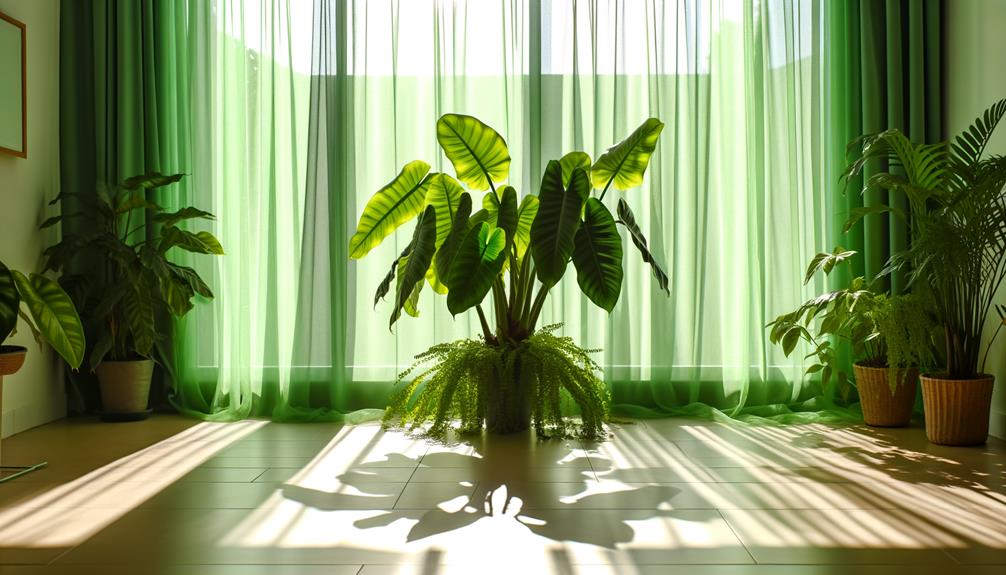
Philodendron Verrucosum hybrids flourish in bright, indirect light, which mimics their natural understory habitat.
Prolonged exposure to direct sunlight can cause leaf scorch and inhibit growth.
Ideal light conditions involve placing the plants in areas with filtered sunlight or using grow lights to maintain consistent illumination.
Ideal Light Conditions
Proper light conditions are crucial for the best growth and vibrant coloration of Philodendron Verrucosum hybrids. These tropical plants thrive in environments that mimic their natural habitat, which includes filtered or indirect sunlight. Achieving prime light conditions involves understanding and maintaining specific parameters:
- Light Intensity:
- Medium to bright indirect light is ideal.
- Too low light can lead to leggy growth, whereas excessive light can cause leaf scorch.
- Duration:
- Ensure plants receive 8-10 hours of appropriate light daily to promote healthy photosynthesis and growth cycles.
- Light Quality:
- Full-spectrum light sources, such as LED grow lights, can mimic natural sunlight effectively, providing the necessary wavelengths for robust development.
Avoiding Direct Sunlight
While maintaining ideal light conditions, it is crucial to avoid direct sunlight, which can cause irreparable damage to Philodendron Verrucosum hybrids. These plants thrive under filtered light, mimicking their natural understory habitat. Exposure to intense sunlight can lead to leaf scorching, discoloration, and significant stress, thereby hindering growth. Utilizing sheer curtains or positioning the plant near east-facing windows can provide optimal light levels without the risk of direct sun exposure.
| Light Condition | Impact on Philodendron Verrucosum Hybrids |
|---|---|
| Direct Sunlight | Leaf scorching, discoloration, growth hindrance |
| Filtered Light | Healthy growth, vibrant foliage |
| Low Light | Slower growth, potential leaf drop |
| Artificial Light | Suitable if broad-spectrum light is provided |
Understanding these requirements ensures the cultivation of healthy, aesthetically pleasing hybrids.
Watering Needs
Guaranteeing proper hydration for Philodendron verrucosum hybrids necessitates a careful balance, as both overwatering and underwatering can lead to significant plant stress and health issues. Effective watering practices are crucial for maintaining the plant's vitality.
Observations indicate that optimal hydration should mimic the natural rainforest habitat, characterized by high humidity and well-draining soil.
Key points to take into account:
- Soil Moisture: Maintain consistent soil moisture without waterlogging by allowing the top inch of soil to dry out between waterings.
- Water Quality: Use filtered or rainwater to avoid mineral buildup, which can impair root function.
- Environmental Humidity: Sustain ambient humidity levels of 60-80% to facilitate healthy transpiration and growth.
These practices collectively promote a robust and thriving Philodendron verrucosum hybrid.
Temperature Tolerance

Philodendron verrucosum hybrids exhibit growth within a temperature range of 65-80°F, necessitating careful monitoring to prevent exposure to extreme temperatures that could inhibit their physiological functions.
These plants, native to tropical regions, thrive in warm, stable environments. Temperatures below 65°F can cause metabolic slowdown, leading to stunted growth and increased susceptibility to pathogens.
Conversely, temperatures exceeding 80°F may result in dehydration and leaf scorch, compromising the plant's overall health. It is imperative to maintain consistent temperature conditions, as fluctuations can stress the plant, affecting its development and vigor.
Utilizing climate control systems, such as humidifiers and heaters, can help simulate ideal conditions, thereby ensuring the optimum growth and sustainability of Philodendron verrucosum hybrids.
Conclusion
Philodendron verrucosum hybrids exhibit enchanting features such as vibrant foliage colors, intricate leaf patterns, and a velvety texture. Their growth habits vary, often requiring specific light conditions and moderate watering to thrive.
These hybrids prefer warm temperatures, demonstrating a minimal tolerance for cold climates. The alluring characteristics of these hybrids—lush leaves, layered luminosity, and luxurious surfaces—underscore their appeal in botanical collections, making them a prized possession for plant enthusiasts and a subject of scientific intrigue.

